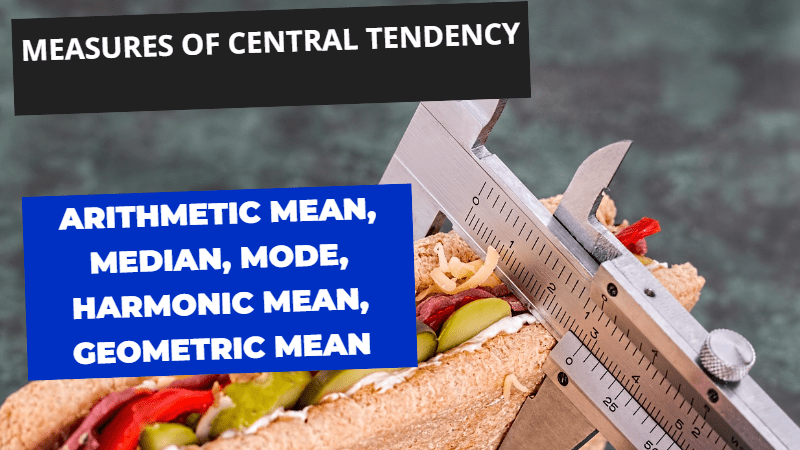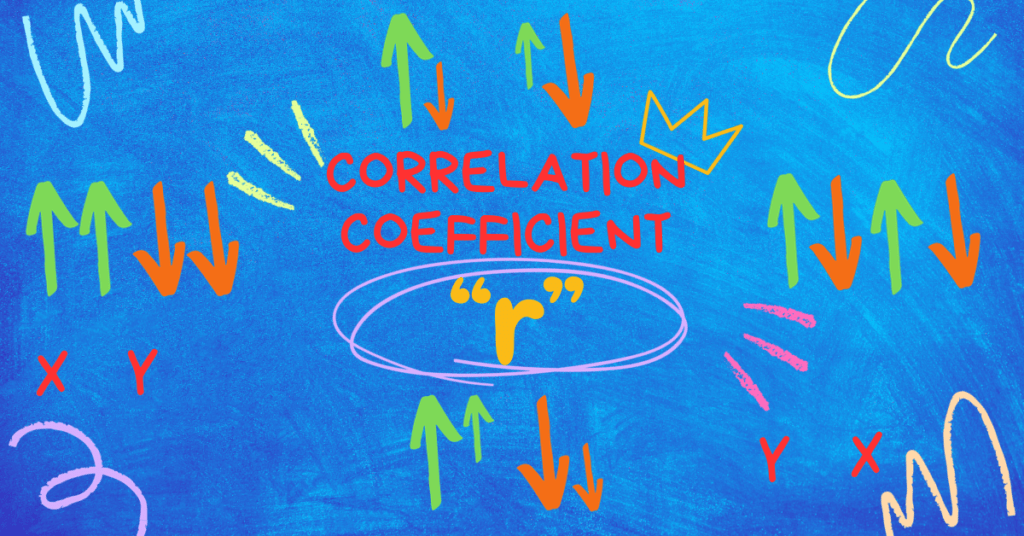Measures of Central Tendency or averages of first order such as Arithmetic Mean, Median, Mode, Harmonic Mean & Geometric Mean. Measures of central tendency calculate the most central value of the data. To know the central value within the distribution of data, there are three methods to calculate it arithmetic mean, median and mode. Besides this, there are two other average Geometric mean which is used for geometric calculations such as index numbers, and Harmonic Mean which is used for rates and ratio purposes used by financial institutions.
Measures of Central Tendency
- Arithmetic Mean
- Median
- Mode
- Harmonic Mean
- Geometric Mean
Table of Contents
Arithmetic Mean
The arithmetic mean is an average to calculate the central value of the data. In ungrouped data, it is the sum of all values divided by the number count of values. It is denoted by:
![]()
Properties of Arithmetic Mean
(i) The sum of the deviation of the mean from its values always equals zero.
![]()
![]()
(ii) The sum of squared deviation from the mean is less than the sum of squared deviation from arbitrary origin
![]()
![]()
(iii) Arithmetic mean has an additive property, which means that if we have multiple distributions mean, we can calculate the combined mean for all distributions.
![]()
(iv) If we have a mean of one distribution and we have a regression equation, we can calculate the mean of another distribution.
![]()
(v) If we have constant values in our distribution, then the mean of that distribution will be that constant value.
Formulas for Arithmetic Mean
We have three different methods to calculate the arithmetic mean:
- Direct Method
- Indirect or Short-Cut Method
- Step Deviation or Coding Method
Formulas for ungrouped data
(1)
![]()
(2)
![]()
(3)
![]()
Example for Understanding ungrouped data
The students of the class obtained marks in the subject of statistics as follows:
| Student | A | B | C | D | E | F | G | H |
| Marks | 20 | 60 | 40 | 80 | 90 | 50 | 60 | 40 |
Calculate the arithmetic mean through the three methods given above.
Solution:
| Students | Marks Obtained (X) | | |
| A | 20 | -30 | -3 |
| B | 60 | 10 | 1 |
| C | 40 | -10 | -1 |
| D | 80 | 30 | 3 |
| E | 90 | 40 | 4 |
| F | 50 Selected as A | 0 | 0 |
| G | 60 | 10 | 1 |
| H | 40 | -10 | -1 |
| Sum | | | |
Note: “A” is an arbitrary origin that you can choose out of X values as per your choice.
“C” is a common divisor on which you can divide all values of “D” easily.
![]()
![]()
![]()
![]()
![]()
Example for understanding grouped data
Calculate arithmetic mean by using:
(a) Direct method
(b) Indirect/Shortcut Method
(b) Step-deviation/Coding method
| Marks | No. of Students |
| 30–39 | 1 |
| 40–49 | 3 |
| 50–59 | 11 |
| 60–69 | 21 |
| 70–79 | 43 |
| 80–89 | 32 |
| 90–99 | 9 |
Solution:
| Marks | f | Class Boundaries | X | fX | D=X-64.5 | fD | U=(X-64.5)/10 | fU |
| 30–39 | 1 | 29.5–39.5 | 34.5 | 34.5 | -30 | -30 | -3 | -3 |
| 40–49 | 3 | 39.5–49.5 | 44.5 | 133.5 | -20 | -60 | -2 | -6 |
| 50–59 | 11 | 49.5–59.5 | 54.5 | 599.5 | -10 | -110 | -1 | -11 |
| 60–69 | 21 | 59.5–69.5 | 64.5 | 1354.5 | 0 | 0 | 0 | 0 |
| 70–79 | 43 | 69.5–79.5 | 74.5 | 3203.5 | 10 | 430 | 1 | 43 |
| 80–89 | 32 | 79.5–89.5 | 84.5 | 2704 | 20 | 640 | 2 | 64 |
| 90–99 | 9 | 89.5–99.5 | 94.5 | 850.5 | 30 | 270 | 3 | 27 |
| Sum | 120 | 8880 | 1140 | 114 | ||||
| ∑f= | ∑fX= | ∑fD= | ∑fU= |
Solution:
(i) Direct Method A.M
![]()
(ii)Indirect or Shortcut Method
![]()
![]()
(iii)Step-deviation or coding Method
![]()
![]()
![]()

Median
Median is also the type of average. It also represents the middle value in the data after arranging data. Median has some properties discussed below:
Properties of Median
- Ordering of the data means the median must be calculated after arranging data in ascending order.
- Not affected by extreme values means the median only focuses on middle values so that it is not affected by extreme outlier values.
- Ordinal Data means the median is not just for numerical data but it also deals with ordinal or categorical data, the data which has categories with order and attributes also.
- Positional value means that the median is called the positional average. After ordering the data, in the odd count of values, the median is most middle value & in even data, the median is the central half value of the sum of two middle values.
- Robust and balanced skewed Distribution means that in skewed distribution where data concentrates on one side of the distribution either left or right, the median provides the best average due to central focus so in this point of view the median has superiority over the arithmetic mean.
Formulas for Median
The formula for ungrouped data:
![]()
The formula for grouped data:
![]()
Example for understanding ungrouped even data:
There are 10 students in a class who got the following marks in the paper of Statistics. Calculate median.
| Students | 1 | 2 | 3 | 4 | 5 | 6 | 7 | 8 | 9 | 10 |
| Marks | 55 | 45 | 40 | 68 | 90 | 50 | 40 | 30 | 25 | 90 |
Solution:
Arranging the data
| Students | 1 | 2 | 3 | 4 | 5 | 6 | 7 | 8 | 9 | 10 |
| Marks | 25 | 30 | 40 | 40 | 45 | 50 | 55 | 68 | 90 | 90 |
![]()
![]()
![]()
![]()
![]()
![]()
![]()
Example for understanding ungrouped odd data:
There are 9 students in a class who got the following marks in the paper of Statistics. Calculate median.
| Students | 1 | 2 | 3 | 4 | 5 | 6 | 7 | 8 | 9 |
| Marks | 55 | 45 | 40 | 68 | 90 | 50 | 40 | 30 | 25 |
Solution:
Arranging the data
| Students | 1 | 2 | 3 | 4 | 5 | 6 | 7 | 8 | 9 |
| Marks | 25 | 30 | 40 | 40 | 45 | 50 | 55 | 68 | 90 |
![]()
![]()
![]()
![]()
Example for understanding grouped odd data:
Find median for the following data:
| Weight | 35–39 | 40–44 | 45–49 | 50–54 | 55–59 | 60–64 |
| Frequency | 3 | 10 | 21 | 15 | 1 | 4 |
Solution
| Marks | f | Class Boundaries | X | C.F |
| 35–39 | 3 | 34.5—39.5 | 37 | 3 |
| 40–44 | 10 | 39.5—44.5 | 42 | 13 |
| 45–49 | 21 | 44.5—49.5 | 47 | 34 |
| 50–54 | 15 | 49.5—54.5 | 52 | 49 |
| 55–59 | 1 | 54.5—59.5 | 57 | 50 |
| 60–64 | 4 | 59.5—64.5 | 62 | 54 |
| ∑f=54=n |
![]()
![]()
![]()
![]()
![]()
![]()

Mode
Mode is also a type of average. In the dataset, mode is the most frequent or most repeated value. Here are some key characteristics or properties of the mode given below:
Properties of Mode
- Multiple means in a dataset, the mode can be multiple because there may be more than one most frequent value.
- Not affected by extreme values means the median only focuses on middle values so that it is not affected by extreme outlier values.
- Nominal Data means, the mode is useful in nominal data. Such as the most frequent bike model sold in the year.
- Not Unique means, there may be no mode in a dataset, if all the observations appear as one time.
- Applicability means, the mode is suitable for categorical data or discrete data but it is also used in continuous data.
Formulas for Mode
Formula for ungrouped data
![]()
Formula for grouped data
![]()
Example for understanding ungrouped data:
During a survey of 10 persons about their monthly income, found the following results:
| Persons | 1 | 2 | 3 | 4 | 5 | 6 | 7 | 8 | 9 | 10 |
| Income |  100 100 | 150 | 300 | 300 | 450 | 500 | 600 | 600 | 650 | 700 |
![]()
![]()
Example for understanding grouped data:
The weights of the 40 male students at a college are given in the following frequency table:
| Weight | 118–126 | 127–135 | 136–144 | 145–153 | 154–162 | 163–171 | 172–180 |
| Frequency | 3 | 5 | 9 | 12 | 5 | 4 | 2 |
Calculate mode.
Solution
| Marks | f | Class Boundaries | X |
| 118–126 | 3 | 117.5—126.5 | 122 |
| 127–135 | 5 | 126.5—135.5 | 131 |
| 136–144 | 9 | 135.5—144.5 | 140 |
| 145–153 | 12 | 144.5—153.5 | 149 |
| 154–162 | 5 | 153.5—162.5 | 158 |
| 163–171 | 4 | 162.5—171.5 | 167 |
| 172–180 | 2 | 171.5—180.5 | 176 |
| Sum | ∑f=40 |
Selection of Model Class: Maximum frequency is 12 so we shall use this class for data.
![]()
![]()
![]()
![]()
Harmonic Mean
The harmonic mean is also a type of average that is useful when dealing with rates, ratios, or overall when data has reciprocal values. It is considered an important average in financial or monetary institutions because it reduces overestimation.
Properties of Harmonic Mean
Inequality
Harmonic Mean is always equal to or less than the arithmetic mean.
Reciprocal Relationship
It is used in the data in which values have reciprocal relationships or the values are in the form of rates and ratios.
Limited Applicability
As discussed above, it is used in reciprocal relationships such as time, speed, rates, ratios, etc. Other than this, it is not suitable for all types of data.
Weighted Harmonic Mean
We can assign weights to the data according to their sensitivity or importance and calculate harmonic mean which is called weighted harmonic mean.
No Commutative and associative property
It means that, unlike arithmetic mean, harmonic mean has no commutative property which means there is no need to order the values, and no associative property which means there is no need to group the values.
Formulas of Harmonic Mean
Formula for Harmonic Mean Ungrouped Data
![]()
Formula for Harmonic Mean Grouped Data
![]()
Example for understanding ungrouped odd data:
ABC Company has 10-year investment return data in fractions given below:
| Year | 2011 | 2012 | 2013 | 2014 | 2015 | 2016 | 2017 | 2018 | 2019 | 2020 |
| Return | 0.10 | 0.15 | 0.08 | 0.30 | 0.20 | 0.25 | 0.15 | 0.10 | 0.25 | 0.20 |
Calculate Harmonic Mean
| Year | Return (X) | 1/X |
| 2011 | 0.10 | 10.0 |
| 2012 | 0.15 | 6.7 |
| 2013 | 0.08 | 12.5 |
| 2014 | 0.30 | 3.3 |
| 2015 | 0.20 | 5.0 |
| 2016 | 0.25 | 4.0 |
| 2017 | 0.15 | 6.7 |
| 2018 | 0.10 | 10.0 |
| 2019 | 0.25 | 4.0 |
| 2020 | 0.20 | 5.0 |
| Sum | 67.2 |
![]()
![]()
Example for understanding grouped odd data:
The percentage of marks of the 40 male students at a college are given in the following frequency table:
| Weight | 20–30 | 30–40 | 40–50 | 50–60 | 60–70 | 70–80 | 80–90 |
| Frequency | 3 | 5 | 9 | 12 | 5 | 4 | 2 |
Calculate Harmonic Mean.
Solution
| Percentage of Marks | f | X | f/x |
| 20–30 | 3 | 25 | 0.120 |
| 30–40 | 5 | 35 | 0.143 |
| 40–50 | 9 | 45 | 0.200 |
| 50–60 | 12 | 55 | 0.218 |
| 60–70 | 5 | 65 | 0.077 |
| 70–80 | 4 | 75 | 0.053 |
| 80–90 | 2 | 85 | 0.024 |
| Sum | ∑f=40 | ∑f/x =0.835 |
![]()
![]()
Geometric Mean
A geometric mean is also a type of average that is defined as the nth root of the product of the n numbers. It deals best with the numbers that grow differently where growth is exponential, multiplicative, or in ratios. It is denoted by G.M. It is widely used in index numbers or used by price monitoring and controlling authorities, financial institutions, and other sciences such as economics, biology, etc.
Properties of Geometric
Non-Negative: The geometric mean is non negative if the data is non negative.
Symmetry: The geometric mean is independent to the order of the data.
Small Value Data Sensitivity: The geometric mean is sensitive to small data variation that means small variation in the data leads to larger outcome variation because of multiplication.
Positive: If all the data values are positive then geometric mean will be greater than zero.
Inequality: If all the data values are positive, the geometric mean will be less than arithmetic mean but if all values are same than case will be different.
Logarithmic Data: if all the data is transformed into logarithmic values then the geometric mean of the data will be equal to the arithmetic mean of the original values data.
Formulas of Geometric Mean
Formula for ungrouped data
![]()
Formula for grouped data
![]()
Example for understanding Ungrouped Data
Calculate geometric mean for the data given below:
| Year | 2018 | 2019 | 2020 | 2021 | 2022 |
| Sugar | 15 | 20 | 10 | 20 | 15 |
Solution:
| Year | Sugar Price | Log X |
| 2018 | 15 | 1.1761 |
| 2019 | 20 | 1.3010 |
| 2020 | 10 | 1.0000 |
| 2021 | 20 | 1.3010 |
| 2022 | 15 | 1.1761 |
| Sum | 5.9542 |
![]()
![]()
![]()
![]()
Example for understanding grouped Data
The following data given the average monthly wages in $ of workers in Harley & Co.
| Wages of workers | No. of Workers | Wages of workers | No. of Workers |
| 140-145 | 1 | 170-175 | 10 |
| 145-150 | 3 | 175-180 | 8 |
| 150-155 | 2 | 180-185 | 5 |
| 155-160 | 4 | 185-190 | 4 |
| 160-165 | 4 | 190-195 | 2 |
| 165-170 | 6 | 195-200 | 1 |
Calculate Geometric Mean
Solution
| Wages of workers | No. of Workers (f) | X | Log X | flogx |
| 140-145 | 1 | 142.5 | 2.1538 | 2.1538 |
| 145-150 | 3 | 147.5 | 2.1688 | 6.5064 |
| 150-155 | 2 | 152.5 | 2.1833 | 4.3665 |
| 155-160 | 4 | 157.5 | 2.1973 | 8.7891 |
| 160-165 | 4 | 162.5 | 2.2109 | 8.8434 |
| 165-170 | 6 | 167.5 | 2.2240 | 13.3441 |
| 170-175 | 10 | 172.5 | 2.2368 | 22.3679 |
| 175-180 | 8 | 177.5 | 2.2492 | 17.9936 |
| 180-185 | 5 | 182.5 | 2.2613 | 11.3063 |
| 185-190 | 4 | 187.5 | 2.2730 | 9.0920 |
| 190-195 | 2 | 192.5 | 2.2844 | 4.5689 |
| 195-200 | 1 | 197.5 | 2.2956 | 2.2956 |
| Sum | 50 | 111.6276 |
Solution:
![]()
![]()
![]()
![]()
Also read:
For practical visual lectures & resources click here





